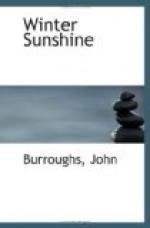All the domestic animals love the apple, but none so much as the cow. The taste of it wakes her up as few other things do, and bars and fences must be well looked after. No need to assort them or to pick out the ripe ones for her. An apple is an apple, and there is no best about it. I heard of a quick-witted old cow that learned to shake them down from the tree. While rubbing herself she had observed that an apple sometimes fell. This stimulated her to rub a little harder, when more apples fell. She then took the hint, and rubbed her shoulder with such vigor that the farmer had to check her and keep an eye on her, to save his fruit.
But the cow is the friend of the apple. How many trees she has planted about the farm, in the edge of the woods, and in remote fields and pastures! The wild apples, celebrated by Thoreau, are mostly of her planting. She browses them down, to be sure, but they are hers, and why should she not?
What an individuality the apple-tree has, each variety being nearly as marked by its form as by its fruit. What a vigorous grower, for instance, is the Ribston pippin, an English apple,—wide-branching like the oak; its large ridgy fruit, in late fall or early winter, is one of my favorites. Or the thick and more pendent top of the bellflower, with its equally rich, sprightly, uncloying fruit.
Sweet apples are perhaps the most nutritious, and when baked are a feast in themselves. With a tree of the Jersey sweet or of the Talman sweet in bearing, no man’s table need be devoid of luxuries and one of the most wholesome of all desserts. Or the red astrachan, an August apple,—what a gap may be filled in the culinary department of a household at this season by a single tree of this fruit! And what a feast is its shining crimson coat to the eye before its snow-white flesh has reached the tongue! But the apple of apples for the household is the spitzenburg. In this casket Pomona has put her highest flavors. It can stand the ordeal of cooking, and still remain a spitz. I recently saw a barrel of these apples from the orchard of a fruit-grower in the northern part of New York, who has devoted especial attention to this variety. They were perfect gems. Not large,—that had not been the aim,—but small, fair, uniform, and red to the core. How intense, how spicy and aromatic!




